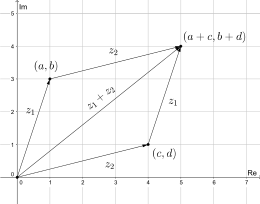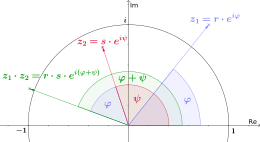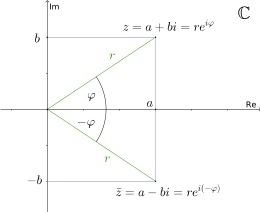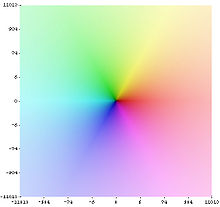Complex number
The complex numbers extend the number range of the real numbers in such a way that the equation 







Complex numbers can be 






The number range of the complex numbers constructed in this way forms an extension body of the real numbers and has a number of advantageous properties that have proved extremely useful in many areas of natural science and engineering. One of the reasons for these positive properties is the algebraic closure of the complex numbers. This means that every algebraic equation of positive degree over the complex numbers has a solution, which is not true for real numbers. This property is the content of the fundamental theorem of algebra. Another reason is a connection between trigonometric functions and the exponential function (Euler formula), which can be established via the complex numbers. Furthermore, every function that can be differentiated once in a complex way on an open set can also be differentiated there as often as desired - unlike in the analysis of the real numbers. The properties of functions with complex arguments are the subject of function theory, also called complex analysis.
.svg.png)
The complex numbers (ℂ) include the real numbers (ℝ) , which include the rational numbers (ℚ), which in turn include the integers (ℤ) and the natural numbers (ℕ)
The letter C with double bar stands for the set of complex numbers
Definition
The complex numbers can be defined as a number range in the sense of a set of numbers for which the basic arithmetic operations of addition, multiplication, subtraction and division are explained, with the following properties:
- The real numbers are contained in the complex numbers. This means that every real number is a complex number.
- The associative law and the commutative law apply to the addition and multiplication of complex numbers.
- The distributive law applies.
- For each complex number
there exists a complex number
such that
.
- For each non-zero complex number
there exists a complex number
such that
.
- There exists a complex number
with property
.
- Among all number ranges with the previously mentioned properties, the complex numbers are minimal.
The last requirement is equivalent to saying that any complex number can be expressed in the form 





Using the notions of bodies and isomorphism, this can be formulated as follows: There are minimal bodies containing the body of real numbers and an element 




The coefficients 
and
and
Calculating in the algebraic form
Addition
For the addition of two complex numbers 



Subtraction
For the subtraction of two complex numbers 

Multiplication
For the multiplication of two complex numbers 

Division
For the division of the complex number 





Calculation examples
Addition:
Subtraction:
Multiplication:
Division:

The addition of two complex numbers in the complex plane illustrates
Other properties
- The body
the complex numbers is on the one hand an upper body of
on the other hand a two-dimensional -vector space
. The isomorphism
also called natural identification. Usually, one also uses this to formally identify
formally as
with the appropriate complex multiplication and then set
. In doing so, it is simultaneously defined:
- The rotation of the complex plane at the origin by the positive angle
transforms the positive real
into the positive imaginary unit
.
- If the positive-real semi-axis goes to the right in the complex plane, then you put the positive-imaginary semi-axis upwards. This is in accordance with the mathematical-positive sense of rotation.
- The body extension
is of degree
; more precisely,
is isomorphic to the factor ring
, where
the minimal polynomial of
over
. Furthermore,
already forms the algebraic closure of
.
- As
vector space,
the basis
. Besides,
as any body is also a vector space over itself, i.e. a one-dimensional
-vector space with base
.
and
are exactly the solutions of the quadraticequation
. In this sense,
(but also
) can be understood as "root of
".
in contrast to
not an ordered body, i.e., there is no linear order relation on
. Therefore, one cannot meaningfully (in terms of addition and multiplication in
) which of the two is the larger or the smaller number.
Amount and metric
Amount
The magnitude 

from its real part 

Examples:
Metrics
The metric induced by the distance function 






Both spaces 

Complex number plane
While the set 







According to the definition, the addition of complex numbers corresponds to vector addition, whereby one identifies the points in the number plane with their location vectors. Multiplication is a rotational extension in the Gaussian plane, which will become clearer after the introduction of the polar form below.
Polarform
If instead of the Cartesian coordinates 





which 



in which 


In the complex number plane, 








Since φ 



![(-\pi;\pi]](https://www.alegsaonline.com/image/e8af0ca359ab41ffbb2f925b360847f630dedbba.svg)


The argument of 
With the choice of a branch of the on the whole of 
All values 

That the multiplication of complex numbers (other than zero) corresponds to rotational extensions can be expressed mathematically as follows: The multiplicative group 


Complex conjugation
→ Main article: Conjugation (mathematics)
If one changes the sign of the imaginary part 




The conjugation 

In the polar representation the conjugate complex number 

The product of a complex number 

The complex numbers thus form a trivial example of a C*-algebra.
The sum of a complex number 

The difference between a complex number 


Conversion formulae
From algebraic form to polar form
For 
For 



![(-\pi;\pi]](https://www.alegsaonline.com/image/e8af0ca359ab41ffbb2f925b360847f630dedbba.svg)
| | | for | |
| | for |
can be determined. Methods that use the arctangent are listed in the article Arc tangent and arc cotangent § Conversion of plane Cartesian coordinates into polar ones. This also includes the variant of the arctangent function often called arctan2, but also atan2, which is available in many programming languages and spreadsheets and which is passed both values and assigns the result to the appropriate quadrant depending on the sign of 
The calculation of the angle φ 

![(-\pi ,\pi ]](https://www.alegsaonline.com/image/7fbb1843079a9df3d3bbcce3249bb2599790de9c.svg)

(see polar coordinates).
From polar form to algebraic form
As above, 

Arithmetic operations in the polar form
The following operands are to be linked together by arithmetic operations:
In multiplication, the amounts 



Trigonometric form
where
and the arctan2 function.
Exponential form
with
and χ
as above.

The division of two complex numbers corresponds to subtracting the angles and dividing the amounts.

Multiplying two complex numbers is the same as adding the angles and multiplying the amounts.
The colour representation of the complex number plane is often used to illustrate complex functions (here: the identity). The colour encodes the argument 

Gaussian plane with a complex number in Cartesian coordinates (a,b) and in polar coordinates (r,φ)
Arithmetic operations 3rd level
Third-level arithmetic operations include exponentiation, root extraction (root extraction) and logarithmisation.
Powers
Natural exponents
For natural numbers 


(see de Moivre's theorem) or for the algebraic form 
Any complex exponents
The general definition of a power with complex base 

where 

Roots
→ Main article: Roots from complex numbers
Logarithms
The complex natural logarithm (unlike the real one on 


With 



The principal value of the natural logarithm of the complex number
is
with 

where is 
Obviously, the logarithm laws apply to the principal value of the natural logarithm only modulo 
The finite subgroups
All elements of a finite subgroup of the multiplicative unit group 


consists. All elements lie on the unit circle.
The union of all finite subgroups is a group isomorphic to the torsion group 

Pragmatic calculation rules
The easiest way to do the calculations is as follows:
- Addition and subtraction of complex numbers are performed (in the algebraic form) component-wise.
- The multiplication of complex numbers can be carried out advantageously in algebraic form or in exponential form (multiplication of the amounts and addition of the arguments (angles)), depending on the specification.
- When dividing complex numbers, in exponential form their amounts are divided and their arguments (angles) subtracted, or in algebraic form the quotient is expanded with the conjugate denominator.
- When exponentiating a complex number with a real exponent, its magnitude is exponentiated and its argument (angle) is multiplied by the exponent; using the algebraic form (with Newton's binomial theorem) is more cumbersome in most cases (especially for higher powers).
- When a complex number with a real exponent is squared (root extraction), its absolute value is squared and its argument (angle) is divided by the exponent. This produces the first solution. An
th root gives
solutions distributed at an angle of
around the origin of the Gaussian plane. See square root (mathematics). A square root can also be calculated quite easily in Cartesian form.
- When multiplying in algebraic form, one of the four multiplications can be saved by the following procedure. However, three additional additions or subtractions are necessary and the calculation is more difficult to parallelise.
Construction of the complex numbers
In this section it is proved that indeed a body 
Pairs of real numbers
The construction initially makes no reference to the imaginary unit 


(which is the ordinary vector addition) a multiplication by
defined.
After this determination one writes 


Since 


represent.
First properties
- The mapping
is a body embedding of
in
due to which we
identify the real number
with the complex number
Regarding the addition is:
- the number
the neutral element (the zero element) in
and
- the number
the inverse element in
.
Regarding multiplication is:
- the number
the neutral element (the one-element) of
and
- the inverse (reciprocal) of
is
.
Reference to the representation in the form a + bi
By 


Every complex number 
with 
Polynomials: Adjunction
Another construction of the complex numbers is the factor ring
of the polynomial ring in an indeterminate over the real numbers. The number 

This principle of construction is also applicable in other contexts, one speaks of adjunction.
Matrices
The set of 

also forms a model of the complex numbers. Here the real unit 



This set is a subspace of the vector space of real 
Real numbers correspond to diagonal matrices
The linear mappings belonging to the matrices, unless 



History
The term "complex numbers" was introduced by Carl Friedrich Gauss (Theoria residuorum biquadraticorum, 1831), the origin of the theory of complex numbers goes back to the Italian mathematicians Gerolamo Cardano (Ars magna, Nuremberg 1545) and Rafael Bombelli (L'Algebra, Bologna 1572; probably written between 1557 and 1560).
The impossibility of a naïve square of the kind 
In a certain sense, the Italian Gerolamo Cardano (1501-1576) had already gone beyond this in his book Artis magnae sive de regulis algebraicis liber unus, published in 1545. There he deals with the task of finding two numbers whose product is 40 and whose sum is 10. He emphasises that the equation to be used for this is
has no solution, but adds some remarks by inserting in the solution
of the general normalised quadratic equation
for 

in such a way that one would be allowed to calculate with this sign according to the same rules as with a real number, the expressions
indeed ever be a solution.
For the square root of negative numbers and more generally for all 


Since the middle of the 17th century, the term imaginary number has become common, which originally came from René Descartes, who used it in his La Géométrie (1637) to express the difficulty of understanding complex numbers as non-real solutions of algebraic equations. John Wallis made the first advances in the 17th century with regard to a geometric interpretation of complex numbers. In 1702, Gottfried Wilhelm Leibniz called them a fine and wonderful refuge of the human mind, almost a hybrid between being and non-being. The introduction of the imaginary unit 
The geometric interpretation was first discovered by the Danish surveyor Caspar Wessel (published in 1799 in the Treatises of the Royal Danish Academy of Sciences, but not known to wider circles until about a hundred years later), by Jean-Robert Argand (in an obscure private print in 1806, but which came to Legendre's attention and became known to wider circles in 1813) and Gauss (unpublished). Gauss explicitly mentions the representation in a letter to Friedrich Bessel of 18 December 1811. After Argand, the geometric representation in the number plane is sometimes also called an Argand diagram.
Augustin-Louis Cauchy is considered the founder of complex analysis in a paper on integration in the complex submitted to the French Academy in 1814, but not published until 1825. In 1821, in his textbook Cours d'analyse, he defined a function of a complex variable in the complex number plane and proved many fundamental theorems of function theory.
Based on philosophical ideas of Immanuel Kant, William Rowan Hamilton found a logically sound justification of the complex numbers as an ordered pair of real numbers in 1833. He interpreted the complex number 

Today, these things do not cause any conceptual or actual difficulties. Due to the simplicity of the definition, the already explained meaning and applications in many scientific fields, the complex numbers are in no way inferior to the real numbers. The term "imaginary" numbers, in the sense of imaginary or unreal numbers, has thus developed over the centuries into a wry but retained designation.
Related topics
- Gaussian numbers and Eisenstein numbers are a generalisation of the integers to the complex numbers.
- Hypercomplex numbers generalise the algebraic structure of the complex numbers.
- Complex-valued functions map complex numbers to complex numbers.
Questions and Answers
Q: What is a complex number?
A: A complex number is a number made up of two parts, the first part being a real number and the second part being an imaginary number.
Q: What is the most important imaginary number?
A: The most important imaginary number is called i, which is defined as a number that will be -1 when squared.
Q: How are arithmetic functions used with complex numbers?
A: Arithmetic functions such as addition, subtraction, multiplication, and division can be used with complex numbers. They also follow commutative, associative and distributive properties just like real numbers.
Q: What symbol represents the set of complex numbers?
A: The set of complex numbers is often represented using the symbol C.
Q: Why were complex numbers discovered?
A: Complex numbers were discovered while attempting to solve special equations that have exponents in them because they posed real problems for mathematicians.
Q: Who introduced writing i for this type of number?
A: It was probably Leonhard Euler who introduced writing i for this type of number.
Q: How can a complex number be written as an ordered pair?
A: A complex number can be written as an ordered pair (a, b), where both a and b are real numbers.
Search within the encyclopedia

































![{\displaystyle {z_{1}\cdot z_{2}=r_{1}\cdot r_{2}\cdot \left[\cos(\varphi _{1}+\varphi _{2})+\mathrm {i} \cdot \sin(\varphi _{1}+\varphi _{2})\right]}}](https://www.alegsaonline.com/image/e62ff8e5407bb9e2c4305c15541c6afd05dd98b4.svg)
![{\displaystyle {\frac {z_{1}}{z_{2}}}={\frac {r_{1}}{r_{2}}}\cdot \left[\cos(\varphi _{1}-\varphi _{2})+\mathrm {i} \cdot \sin(\varphi _{1}-\varphi _{2})\right]}](https://www.alegsaonline.com/image/60f083948a3c782e559539ed80b1c93f8092552d.svg)






































